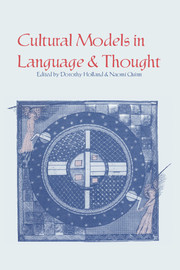
-
Select format
-
- Publisher:
- Cambridge University Press
- Publication date:
- 05 June 2012
- 30 January 1987
- ISBN:
- 9780511607660
- 9780521311687
- Dimensions:
- Weight & Pages:
- Dimensions:
- (228 x 152 mm)
- Weight & Pages:
- 0.668kg, 416 Pages
- Subjects:
- Social Psychology, Anthropology, Psychology, Anthropological Theory
You may already have access via personal or institutional login- Subjects:
- Social Psychology, Anthropology, Psychology, Anthropological Theory
Book description
The papers in this volume, a multidisciplinary collaboration of anthropologists, linguists, and psychologists, explore the ways in which cultural knowledge is organized and used in everyday language and understanding. Employing a variety of methods, which rely heavily on linguistic data, the authors offer analyses of domains of knowledge ranging across the physical, social, and psychological worlds, and reveal the importance of tacit, presupposed knowledge in the conduct of everyday life. The authors argue that cultural knowledge is organized in 'cultural models' - storylike chains of prototypical events that unfold in simplified worlds - and explore the nature and role of these models. They demonstrate that cultural knowledge may take either proposition-schematic or image-schematic form, each enabling the performance of different kinds of cognitive tasks. Metaphor and metonymy are shown to have special roles in the construction of cultural models. The authors also demonstrates that some widely applicable cultural models recur nested within other, more special-purpose models. Finally, it is shown that shared models play a critical role in thinking, allowing humans to master, remember, and use the vast amount of knowledge required in everyday life. This innovative collection will appeal to anthropologists, linguists, psychologists, philosophers, students of artificial intelligence, and other readers interested in the processes of everyday human understanding.
Reviews
"This book, emphasizing as it does the role of the cultural component in human knowledge, should be of interest to students of anthropology, linguistics, and psychology, as well as to specialists in the fields of artificial intelligence and cognitive science." Studies in Second Language Learning
Contents
Metrics
Altmetric attention score
Full text views
Full text views help Loading metrics...
Loading metrics...
* Views captured on Cambridge Core between #date#. This data will be updated every 24 hours.
Usage data cannot currently be displayed.
Accessibility standard: Unknown
Why this information is here
This section outlines the accessibility features of this content - including support for screen readers, full keyboard navigation and high-contrast display options. This may not be relevant for you.
Accessibility Information
Accessibility compliance for the PDF of this book is currently unknown and may be updated in the future.


